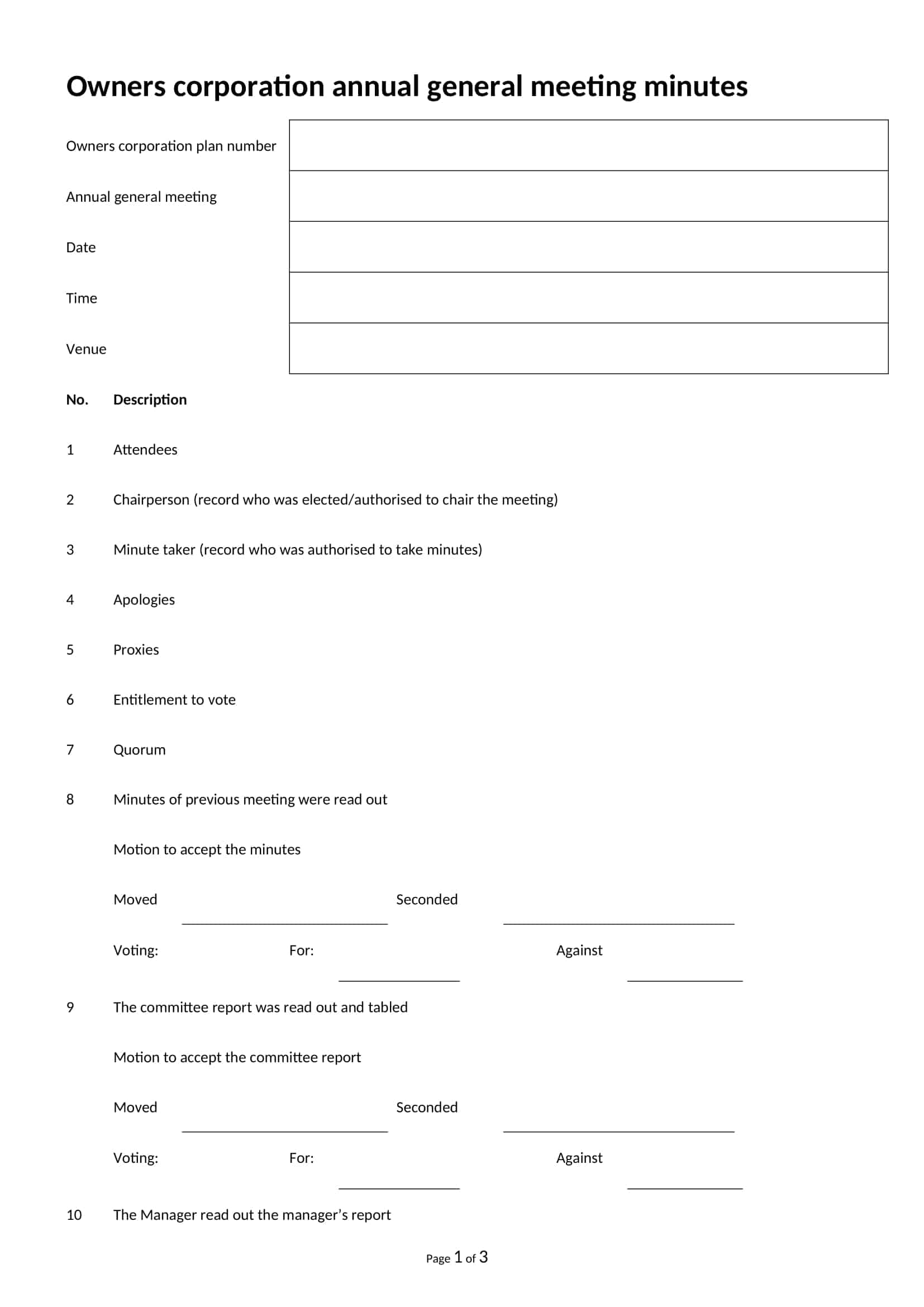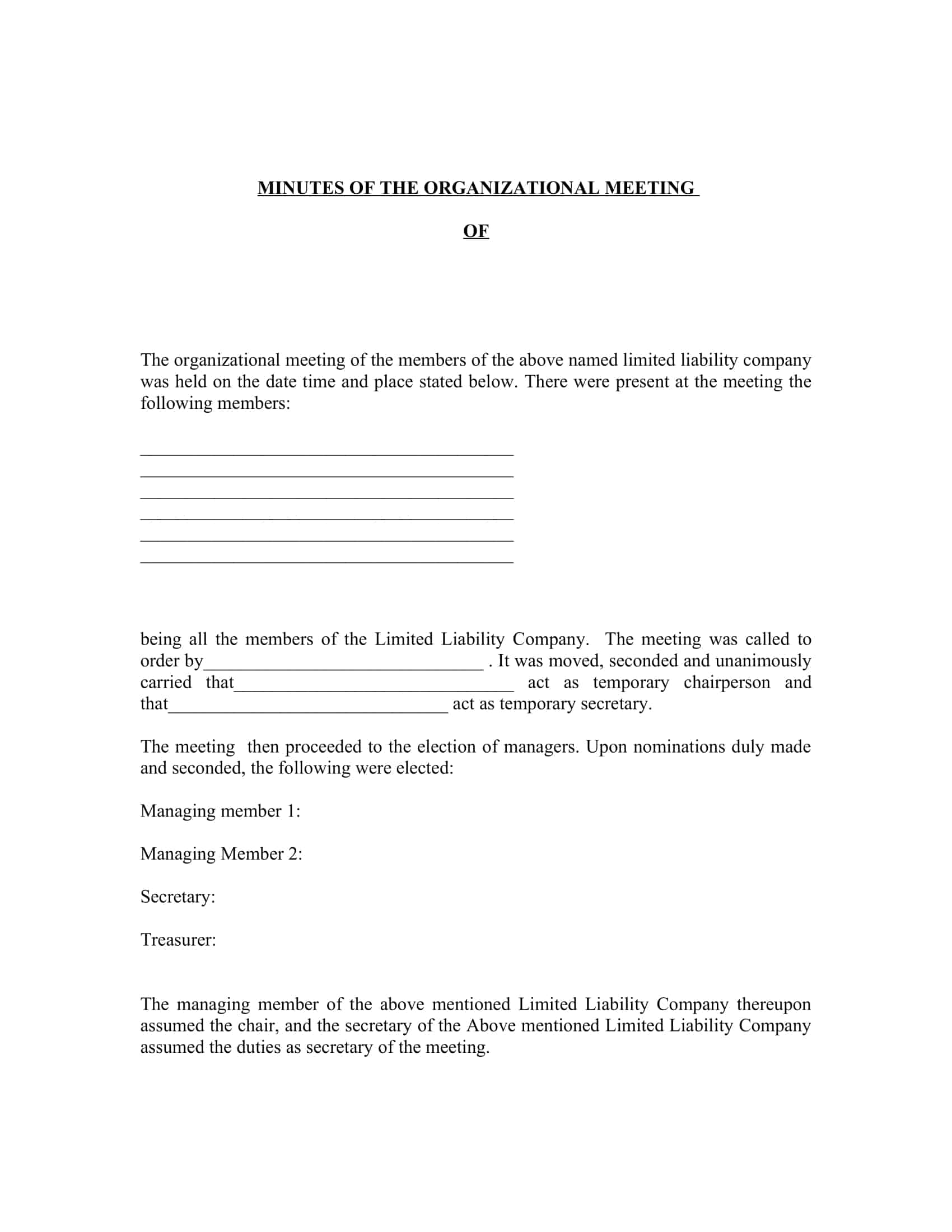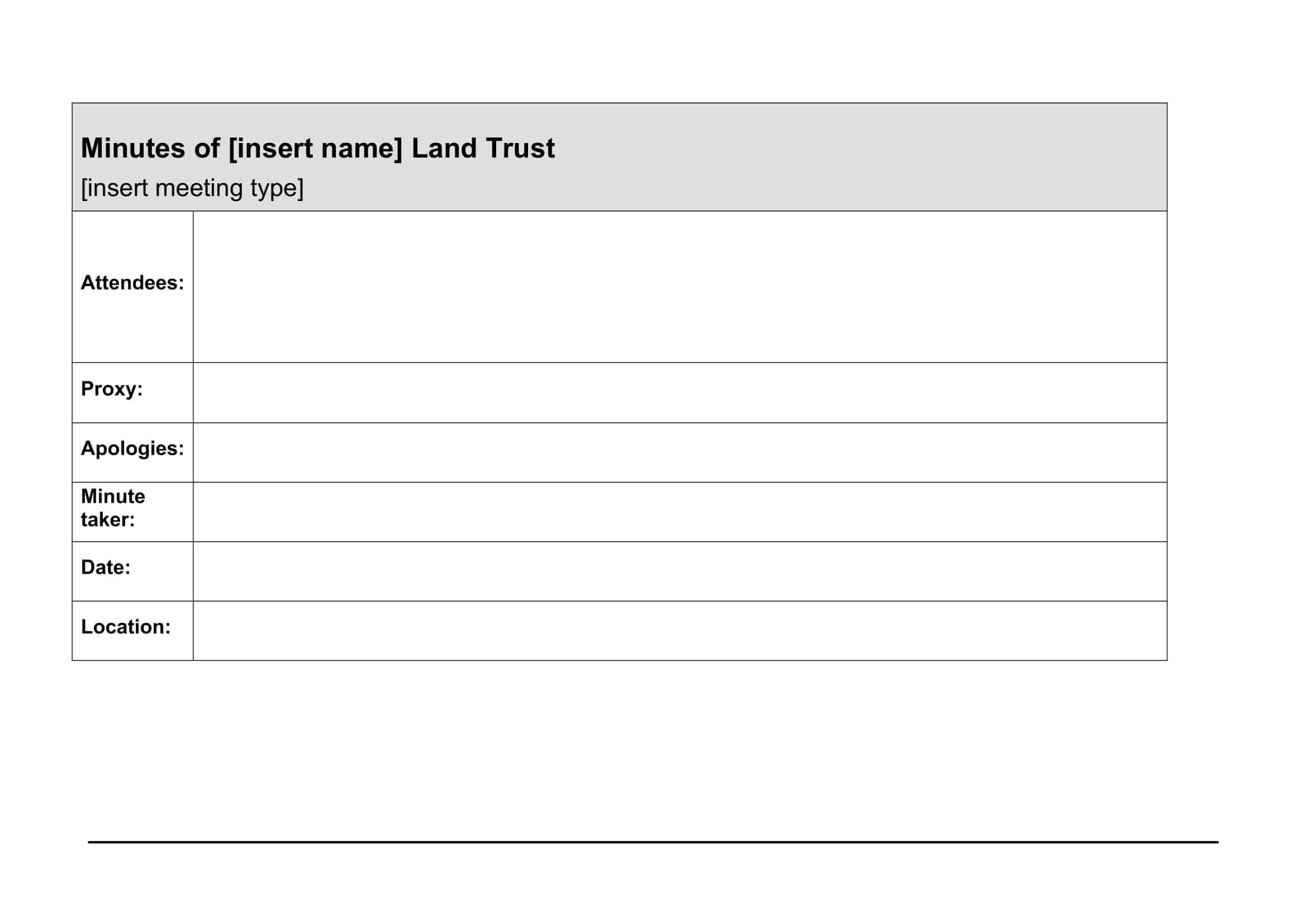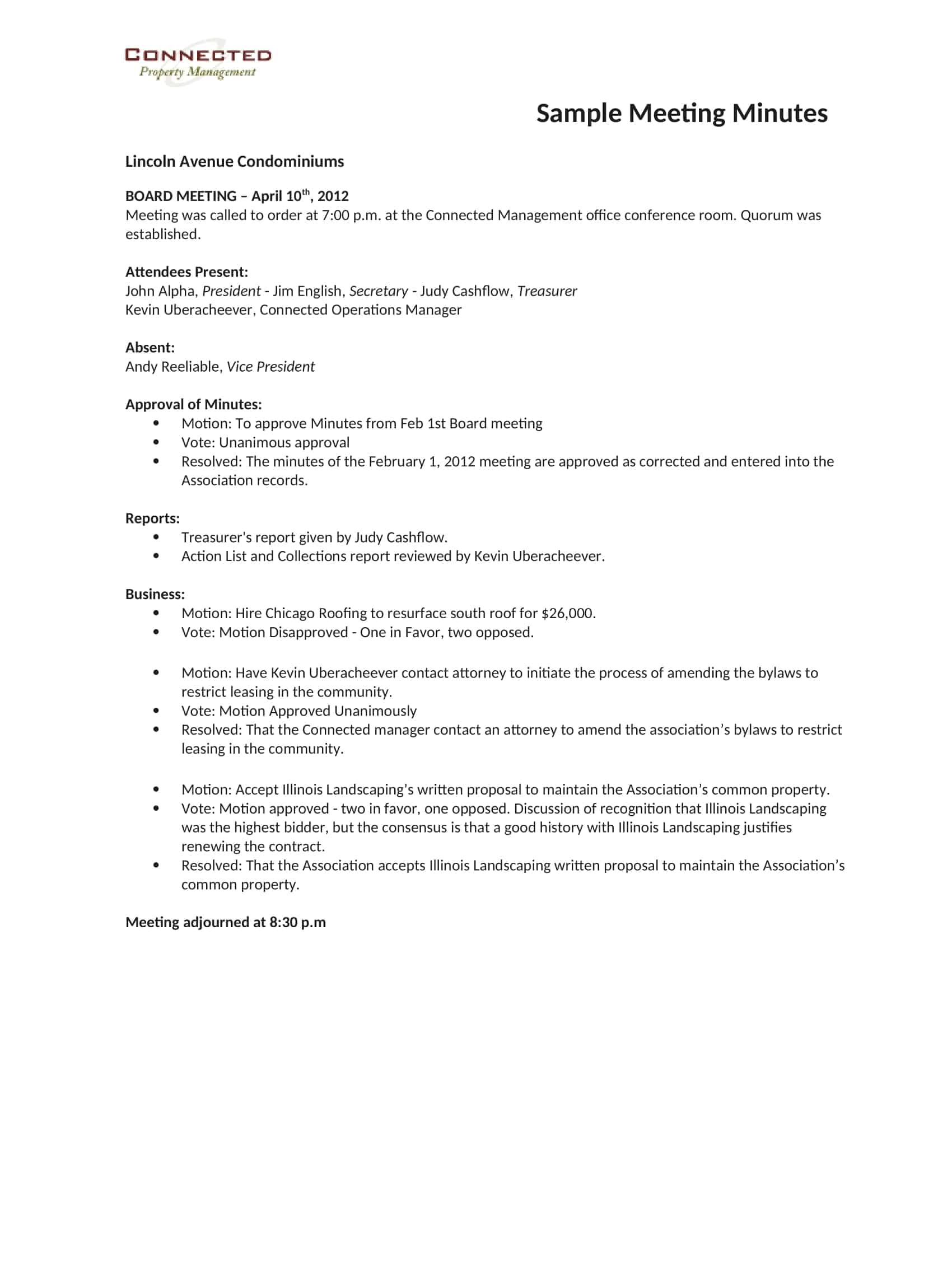Employees who are aware of the corporate policies and standards will be able to perform their duties in an effective manner. Only with the help and presence of all employees can these tasks be performed efficiently. They will function as required by the day-to-day business operations taking place inside your corporation. Preparation of corporate minutes is a way to track how effectively the employees are doing their job.
Table of Contents
Corporate Meeting Minutes Templates
Corporate Meeting Minutes serve as an official record of the discussions, decisions, and actions taken during a corporate meeting. They provide a comprehensive summary of the meeting proceedings and serve as a reference for participants and stakeholders. The Corporate Meeting Minutes Template provides a structured format for creating this document.
It is important to note that the specific requirements and format of Corporate Meeting Minutes may vary depending on the jurisdiction, the type of organization, and any specific regulations or bylaws. It is recommended to consult with legal professionals or follow any applicable organizational guidelines to ensure compliance.
Corporate Meeting Minutes Templates can be customized using word processing software or online templates. They provide a standardized and professional format for documenting the proceedings of corporate meetings. By using a Corporate Meeting Minutes Template, organizations can maintain accurate records, ensure transparency, and facilitate effective decision-making and follow-up actions based on the discussions and decisions made during the meeting.
What are Corporate Meeting Minutes?

Corporate meeting minutes are the official notes of discussions and actions taken during a company board of directors’ meeting. Meeting minutes are prepared by an appointed individual, such as a board secretary or corporate secretary, or the corporate secretary’s assistant may prepare them.
Corporate minutes are vital to maintaining compliance with state laws and Federal regulations for all business transactions. For instance, if a company fails to maintain proper corporate minutes, consequences ranging from fines to suspended operations may be enforced. Furthermore, unrecorded meetings would have a negative impact on shareholders due to failing to keep track of recent corporate proceedings.
Why Take Corporate Meeting Minutes?
Taking minutes might be easy for some, but many others also find it difficult as there are no specific rules you need to follow. Corporate meeting minutes are a handy tool for keeping track of the proceedings of your meetings. It not only gives you a reference to look back on when you forget something that was discussed and agreed upon but also acts as a legal document in case of any future disputes and can protect you from litigation.
To boost your sale price and attract investors.
If you plan to sell your business at some point, then taking corporate meeting minutes is an absolute must. This will give potential buyers confidence in your business and help them understand its current well-managed. Taking good notes of meetings can also help boost the sale price of your company by showing potential buyers that you have been maintaining good records about how your business operates internally.
Keep the company’s tax standing.
The IRS requires that businesses keep a record of all business transactions for five years after filing their returns. Meeting minutes help you keep the records up-to-date and in order. It will be easier for you to prepare your taxes when the time comes because you already have everything documented and organized.
Safeguards liability protection
Meeting minutes can also protect your personal assets from lawsuits brought against your company if any accidents occur during meetings or events held by the company. They can even prove as evidence in court if necessary. This is especially true if there are no witnesses present during meetings and someone gets injured because of negligence on the part of management or employees in charge. You might lose a lot more than just money if there is no proof that what happened was not intentional or negligent on your part.
Acts as a reminder
Meeting minutes act as a reminder for future meetings. Not only do they ensure that no essential points are forgotten, but they also help in building better relationships between members of the same organization. The meetings are more productive when everyone is on the same page and knows what they need to achieve at each meeting.
Provides clarity in decision-making
Meeting minutes provide clarity in decision-making by recording each member’s inputs and comments during the course of the discussion. This ensures that there is no confusion about who said what and when they said it. This way, everyone knows where they stand with regard to each issue discussed during the meeting. If there is any confusion or if someone wants clarification on something, all they have to do is check out their own copy of the meeting minutes and go through them again until they understand everything clearly without any ambiguity or doubt left over from their previous meetings.
Important Elements of Corporate Meeting Minutes
The following are some vital elements of corporate meeting minutes:
Meeting time, date, and venue.
It is essential to mention the exact time when the meeting took place. Also, it is necessary to mention the place where it was held. This will help people who were unable to attend due to some reasons. For example, if you held a teleconference with your employees in different cities or countries, then you need to mention their locations as well as the dates and times of calls.
Agenda items and short description
The agenda item refers to each topic that has been discussed during a meeting or conference. You need to mention each item on your agenda, like the objectives of your appointment, etc., so that people can remember what has been discussed during that particular session. This way, attendees can also refer back to their notes or documents regarding each topic covered during the meeting or conference.
The attendees’ names
The names of all persons present at the meeting. Attendees should be listed in order of importance, beginning with officers and directors, followed by senior executives and others who are important to the corporation. If there are no officers or directors, then the names should be listed in alphabetical order by last name.
Names of attendees absent
Suppose any person cannot attend a corporate meeting. In that case, it is important for them to notify all other attendees and notify the secretary in writing or by email before or during the meeting. The names of all other attendees should be recorded at the beginning of each meeting agenda and included in the minutes.
Voting action and how every person voted
Any voting on business matters at a corporate meeting should be recorded whether each vote was by show of hands or by secret ballot. It is also advisable to record how many people abstained from voting if this happened during a vote taken by show of hands. In addition, it is important to record how many votes were cast against taking any particular action so that shareholders know how many shares were not voted in favor of taking a particular action.
The duration of the meeting
This can be noted down very easily as it is usually recorded on a digital clock or timer at the venue itself. The start and end times can be mentioned clearly in the minutes.
How to Write Corporate Meeting Minutes
When you are in charge of writing corporate meeting minutes, keeping a record of everything that happens during the meeting is important. This will help in the future when you need to refer to the minutes and also in case a dispute arises regarding the proceedings of the meeting.
If you are not sure how to write corporate meeting minutes, here are some steps that will guide you through the process:
Taking meeting notes
The first step in creating corporate meeting minutes is to take accurate notes. To do this, you need to pay attention to what’s being said and jot down important points. Type your notes into your computer or tablet as soon as possible after the meeting so that you can refer back to them later on if necessary. If you’re not able to type your notes immediately after the meeting, make sure that you write them down in a notebook or on paper so that they can be noticed.
Type the meeting notes
Once you’ve taken your notes, type them up as accurately as possible into a document on your computer or tablet — don’t worry too much about formatting at this point because you’ll go back later and format them properly once they’ve been approved by everyone involved in the meeting.
Circulate the draft
Once you’ve typed up an initial version of your minutes and double-checked them for any mistakes or typos, circulate it amongst the relevant people for approval — including anyone who didn’t attend the original meeting but needs to know what was discussed (e.g., other members of management).
Distribute minutes to the entire board
Once you have prepared your corporate meeting minutes, distribute them to all board members for their review. Make sure everyone has enough time to review and make comments before the next meeting.
Vote to approve
Once everyone has reviewed the minutes, vote on whether or not they should be approved. If there are no objections, then it is time to move forward with signing off on the final draft of your corporate meeting minutes.
Sign minutes
Make sure that each member signs his or her name at the bottom of your corporate meeting minutes page. You can also ask your secretary to sign as well so that he or she knows that he or she has received them. This will make it easier for him or her when distributing copies of these documents in future meetings.
Keep the approved minutes.
Once your meeting is over, it is equally important to keep a copy of the approved minutes with you. This will help you verify information and provide answers in case someone asks for them later.
Final Thoughts
It is important to note that minutes should be taken down by someone present during the meeting and must contain facts only. This ensures that there are clear understandings with regard to what was discussed and what decisions were made. All attendees must understand the purpose of these minutes, as it is a very effective instrument for following up on projects.
FAQs
Is there a meeting minutes template in Word?
Yes, Word provides a simple minutes template with sections for meeting info, agenda, attendee list, discussion recap, motions, voting results, action items, and next steps. Styles help with formatting and spacing for consistency. The template is easily customizable.
Should a minutes template be used for informal meetings too?
While formal minutes are important for official board meetings and shareholder meetings, they may be overly structured for informal department status meetings. For internal team meetings, a simple bulleted list capturing key discussion points and action items may suffice.
How soon after a meeting should the minutes be sent?
To ensure accuracy, minutes should be completed and distributed within 24-48 hours of the meeting ending. This allows attendees to review while discussion details are still fresh. Minutes should be finalized before sending.
Should minutes include attribution for who said what?
Generally, minutes should summarize discussions objectively without attributing statements to specific people. Exceptions could be made for formal motions, reports, or presentations where the speaker should be named. For sensitive topics, anonymity protects open dialogue. Attribution is not common practice for minutes.
How do you write minutes for a corporate meeting?
- Include meeting details like date, time, location, purpose, and attendees. Note absent members.
- List agenda items and note who presented each one.
- Summarize discussions objectively, capturing key points, questions, and decisions.
- Detail all motions made and votes taken. Indicate who made the motion and voting results.
- Record action items with owners and deadlines.
- Include next steps like date of next meeting.
- Use formal professional language suited to a business setting.
What do corporate meeting minutes look like?
Corporate minutes follow a standard structure:
- Header with meeting details
- Ordered agenda items numbered and titled
- Concise paragraphs summarizing each topic discussion
- Tables reporting motions and votes
- Numbered list of action items and owners
- Professional tone without colloquialisms
Is there a standard format for minutes of the meeting?
Yes, standard elements include:
- Heading: Meeting name, date, time, location
- Opening: List of attendees and absentees
- Body: Agenda items, discussions, motions, votes
- Closing: Action items, next steps, next meeting date/time
- Formatted neatly with consistent styles and numbering



































![Free Printable Roommate Agreement Templates [Word, PDF] 1 Roommate Agreement](https://www.typecalendar.com/wp-content/uploads/2023/06/Roommate-Agreement-150x150.jpg)
![Free Printable Credit Card Authorization Form Templates [PDF, Word, Excel] 2 Credit Card Authorization Form](https://www.typecalendar.com/wp-content/uploads/2023/06/Credit-Card-Authorization-Form-150x150.jpg)
![Free Printable Stock Ledger Templates [Excel,PDF, Word] 3 Stock Ledger](https://www.typecalendar.com/wp-content/uploads/2023/08/Stock-Ledger-150x150.jpg)
